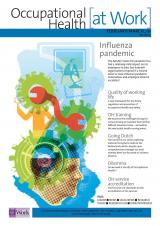February/March 2010 (vol. 06/5)
ContentsFeaturesResearch PlusCPD
Research Plus
OH interventions should target at-risk workers
A targeted OH intervention based on personal assessment, OH consultation, referral where necessary and action plans drawn up by the OH nurse or physician has the greatest impact on those workers who perceive that they are unlikely to be able to continue working1. The study is a follow-up of a previously published randomised controlled trial that demonstrated the effectiveness of a targeted intervention on workers with a high-risk of sickness absence2. The high-risk group included workers with poor future work ability, pain, musculoskeletal problems, fatigue, stress and high depression score. Workers with poor health status were randomised to the targeted OH intervention or ‘usual care’, with their absence followed for 12 months. The usual care group could consult the OH professional on request, but they did not get feedback on their health survey results; nor were they invited for an OH consultation. The sub-group analysis found that the intervention was most effective in workers with self-rated future work inability (p = 0.00003), severity of physical impairment (p = 0.009) and comorbidity (p = 0.01).
- Journal of Occupational Rehabilitation 2009; online first: doi: 10.1007/s10926-009-9221-0. http://link.springer.com/article/10.1007%2Fs10926-009-9221-0
- Occupational & Environmental Medicine 2008; 65: 236–241. http://oem.bmj.com/content/65/4/236.abstract
Occupational Health at Work February/March 2010 (vol. 06/5) pp40



